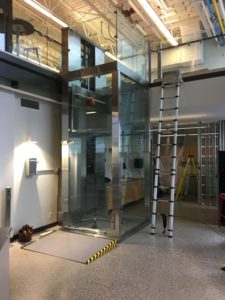Camosun College is finishing installing an elevator to the upper-floor mezzanine in the main atrium of the Centre for Trades Education and Innovation (CTEI) building at Interurban. The building, which opened in 2015, originally had no elevator to the mezzanine. However, after hearing student opinion on the matter, the college has added one in, at a total cost of approximately $260,000.
The BC Building Code did not require the mezzanine to have an elevator, and the college was facing some “pretty significant budget constraints” around the building, says Camosun director of Facilities Services Ian Tol, so the college chose to not install one.
“The logic behind it was that both the main floor atrium as well as the upper floor mezzanine were more or less performing a similar function, where it was a place for gathering, and because of the full accessibility and availability of the main floor space, at the time we felt okay about the decision to not put an elevator in to also provide accessibility to the upper space,” says Tol.

Tol—who confirms that all crucial building functions, such as classes, were restricted to the accessible main-floor atrium—says that soon after construction of CTEI completed, people began objecting to the lack of elevator to the mezzanine.
“We used the atrium of the building for events and whatnot—mind you, they always took place on the main floor, so the upper area was not really used for any of those events, but it kind of highlighted what was there,” he says. “We did receive feedback from the college community that they felt that that was a miss that there was no access to that upper area, and some of those were also college employees. So some time later we looked at it again and came to a different conclusion and agreed that we should provide that accessibility.”
Camosun College Student Society (CCSS) student wellness and access director Eleanor Vannan believes that Camosun excels at correcting its missteps.
“It’s always heartening to see people acknowledging when there has been an oversight and rectifying that, and that’s something that in my experience Camosun is very good at, that they don’t try and cover up things, they really own it and do the right thing in the end,” she says.
Vannan applauds the college for addressing issues before objections become hostile.
“One of the things I will always give Camosun credit on is that they will do the right thing prior to students having to force them to,” she says. “Beyond vocalizing it, I wouldn’t say there was really any aggressive proactive or adversarial steps taken. I think we need to, as students, understand the different levels of pressure we sometimes have to put on institutions about things, and being vocal about something is really the first step, and there are lots of times we can be vocal about something and we aren’t listened to.”
Tol says that hearing student feedback is a priority for the college.
“I think it’s certainly safe to say that accessibility and providing barrier-free access is a priority for the college,” he says. “It’s certainly important, and I think all students have a right to be able to enjoy the college fully regardless of ability.”
Tol says that in the future, Camosun will try to consider wider perspectives when designing buildings in order to reduce the amount of retroactive action necessary.
“I guess the best you can do is learn from these things, and moving forward try to ensure that you don’t have to go back and correct things after the fact. I think there is something to be said for specifically looking at accessibility in a more in-depth way other than relying on what the BC Building Code requires,” he says. “Of course that’s the minimum standard we have to meet, so it does cover off a number of eventualities, but at the same time, there’s such a wide variety [of] need that exists, and I do think that we need to take a closer look at accessibility for future building projects and make that a specific area to focus on, to make sure we don’t miss any opportunities.”
Vannan says that in her experience in Canadian post-secondary, Camosun is a leader in accessibility, but she cautions against considering this achievement a trophy to simply step back and admire.
“It is important that when you are that leader to not sit on your laurels, to constantly be pushing yourself further and really be reviewing if you are still as accessible as you claim to be, because the worst thing is to slowly slip behind,” she says. “So I’d say of students, critically look around, raise issues of accountability in your social circles, with your faculty, through the CCSS and the Nexus, because it’s really going to be all of us together creating a culture of access that is going to maintain Camosun as a leader, and a truly accessible school.”
